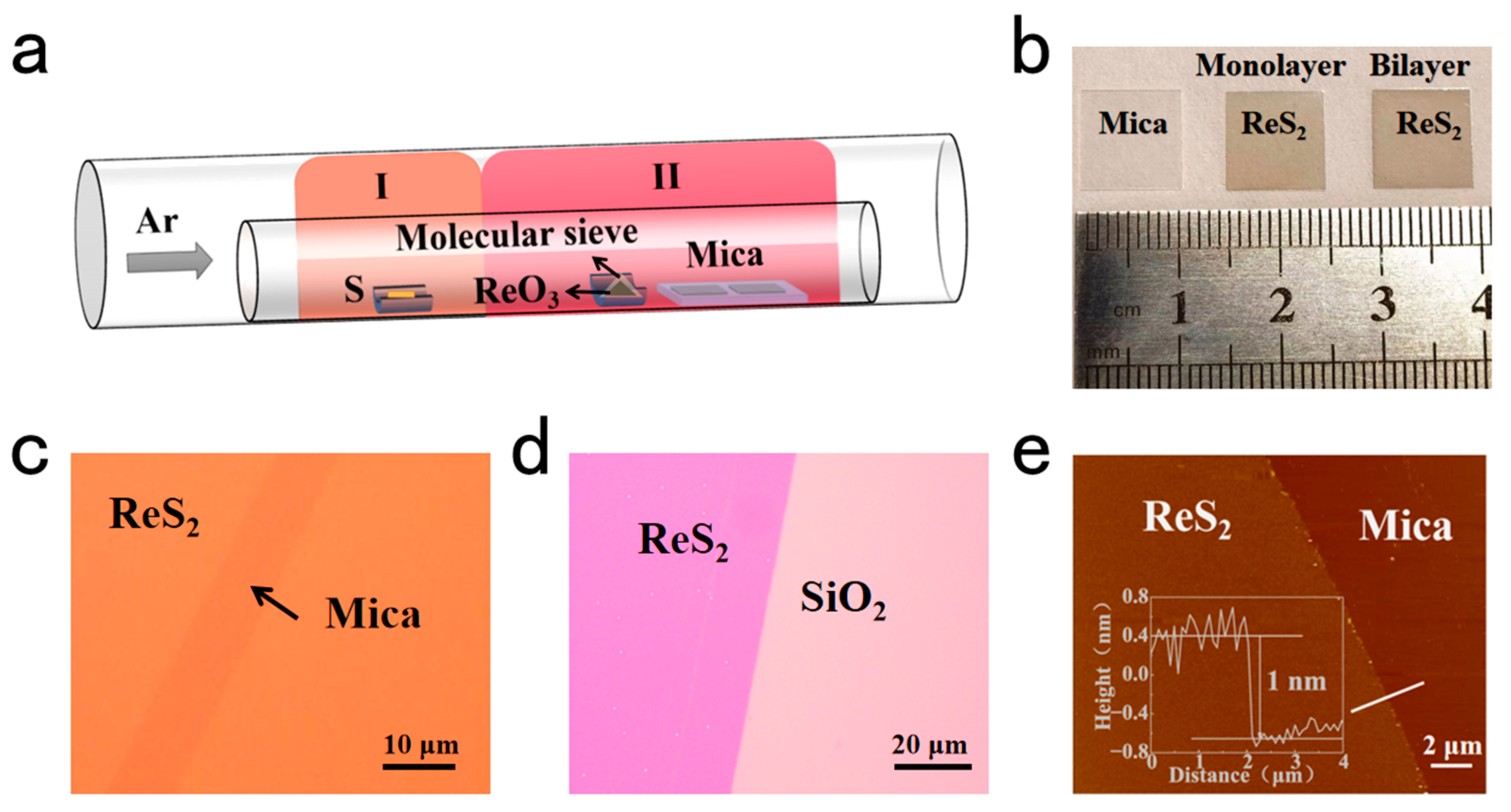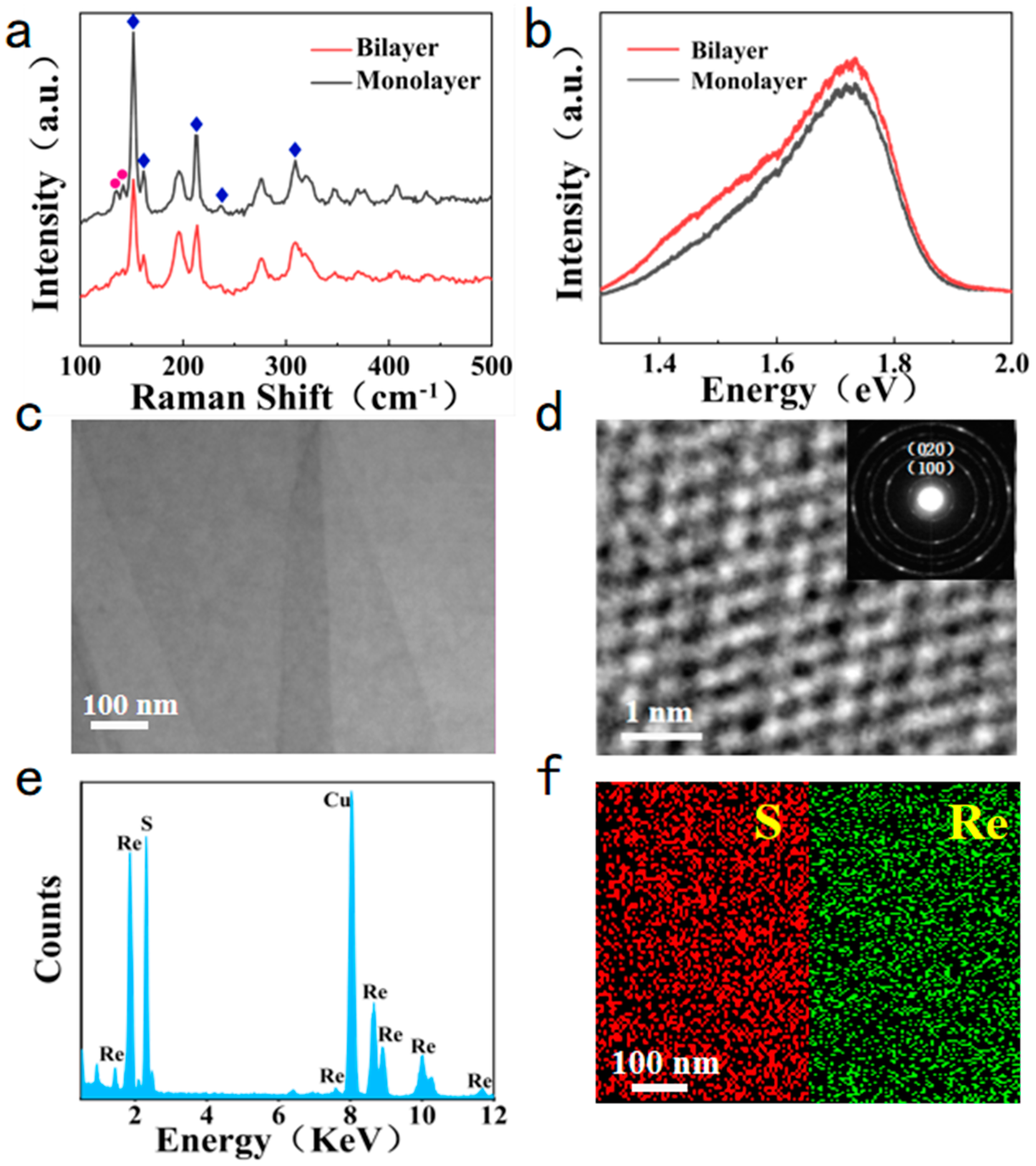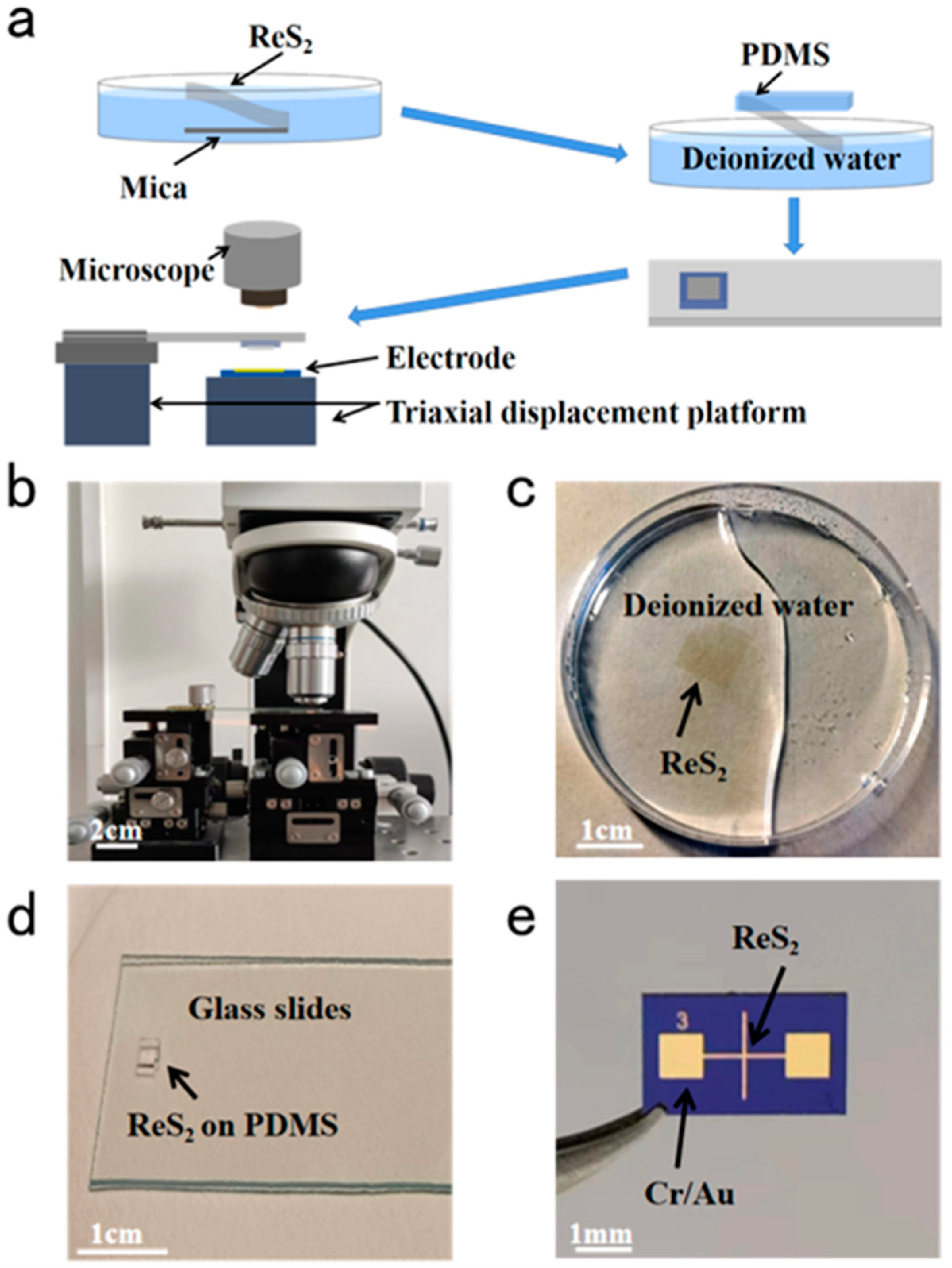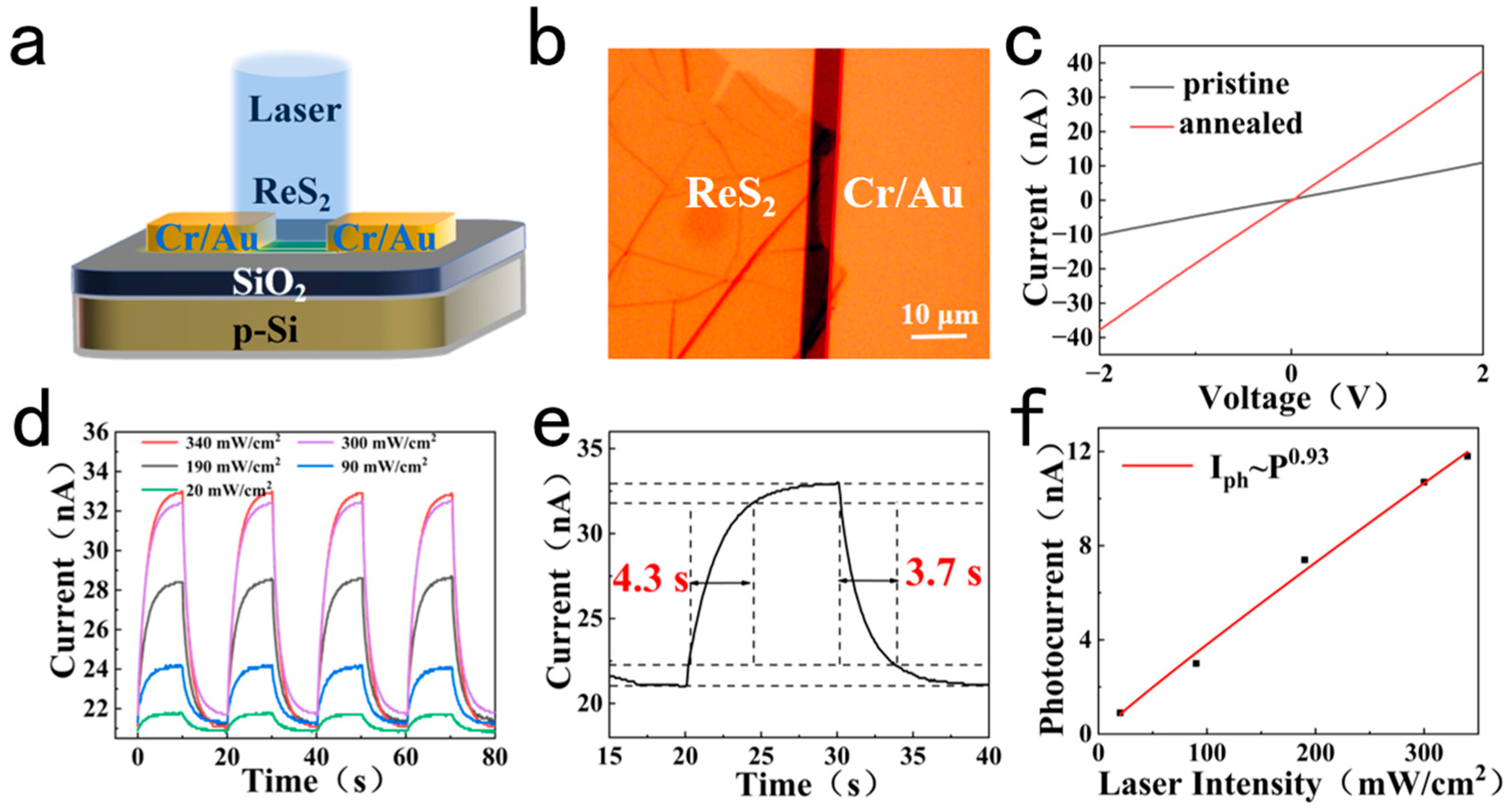Controllable Growth of Large-Scale Continuous ReS2 Atomic Layers
Abstract
:1. Introduction
2. Materials and Methods
2.1. Growth of ReS2
2.2. Characterizations of Samples
2.3. Fabrication and Measurement of Photodetectors
3. Results and Discussion
3.1. Growth and Characterization of ReS2 Film
3.2. Optoelectronic Properties of ReS2 Films
4. Conclusions
Supplementary Materials
Author Contributions
Funding
Data Availability Statement
Conflicts of Interest
References
- Chhowalla, M.; Shin, H.S.; Eda, G.; Li, L.-J.; Loh, K.P.; Zhang, H. The chemistry of two-dimensional layered transition metal dichalcogenide nanosheets. Nat. Chem. 2013, 5, 263–275. [Google Scholar] [CrossRef] [PubMed]
- Jariwala, D.; Sangwan, V.K.; Lauhon, L.J.; Marks, T.J.; Hersam, M.C. Emerging device applications for semiconducting two-dimensional transition metal dichalcogenides. ACS Nano 2014, 8, 1102–1120. [Google Scholar] [CrossRef] [PubMed]
- Han, G.H.; Duong, D.L.; Keum, D.H.; Yun, S.J.; Lee, Y.H. van der Waals metallic transition metal dichalcogenides. Chem. Rev. 2018, 118, 6297–6336. [Google Scholar] [CrossRef] [PubMed]
- Jariwala, D.; Davoyan, A.R.; Wong, J.; Atwater, H.A. Van der Waals materials for atomically-thin photovoltaics: Promise and outlook. ACS Photonics 2017, 4, 2962–2970. [Google Scholar] [CrossRef]
- Chaves, A.; Azadani, J.G.; Alsalman, H.; Da Costa, D.; Frisenda, R.; Chaves, A.; Song, S.H.; Kim, Y.D.; He, D.; Zhou, J. Bandgap engineering of two-dimensional semiconductor materials. Npj 2D Mater. Appl. 2020, 4, 29. [Google Scholar] [CrossRef]
- Wang, Q.H.; Kalantar-Zadeh, K.; Kis, A.; Coleman, J.N.; Strano, M.S. Electronics and optoelectronics of two-dimensional transition metal dichalcogenides. Nat. Nanotechnol. 2012, 7, 699–712. [Google Scholar] [CrossRef]
- Rahman, M.; Davey, K.; Qiao, S.Z. Advent of 2D rhenium disulfide (ReS2): Fundamentals to applications. Adv. Funct. Mater. 2017, 27, 1606129. [Google Scholar] [CrossRef]
- Li, X.; Chen, C.; Yang, Y.; Lei, Z.; Xu, H. 2D Re-Based Transition Metal Chalcogenides: Progress, Challenges, and Opportunities. Adv. Sci. 2020, 7, 2002320. [Google Scholar] [CrossRef]
- Steinberg, D.; Zapata, J.D.; Nascimento, R.; Rosa, H.G.; Saito, L.A.; de Souza, E.A.T. Mode-locked erbium-doped fiber laser based on a mechanically exfoliated ReS2 saturable absorber onto D-shaped optical fiber. Opt. Mater. Express 2022, 12, 1657–1669. [Google Scholar] [CrossRef]
- Liu, F.; Zhao, X.; Yan, X.-Q.; Xie, J.; Hui, W.; Xin, X.; Liu, Z.-B.; Tian, J.-G. Ultrafast nonlinear absorption and carrier relaxation in ReS2 and ReSe2 films. J. Appl. Phys. 2019, 125, 173105. [Google Scholar] [CrossRef]
- Liu, H.; Li, Z.; Yu, Y.; Lin, J.; Liu, S.; Pang, F.; Wang, T. Nonlinear optical properties of anisotropic two-dimensional layered materials for ultrafast photonics. Nanophotonics 2020, 9, 1651–1673. [Google Scholar] [CrossRef]
- Fadhel, M.M.; Ali, N.; Rashid, H.; Sapiee, N.M.; Hamzah, A.E.; Zan, M.S.D.; Aziz, N.A.; Arsad, N. A review on rhenium disulfide: Synthesis approaches, optical properties, and applications in pulsed lasers. Nanomaterials 2021, 11, 2367. [Google Scholar] [CrossRef] [PubMed]
- Zhang, E.; Wang, P.; Li, Z.; Wang, H.; Song, C.; Huang, C.; Chen, Z.-G.; Yang, L.; Zhang, K.; Lu, S. Tunable ambipolar polarization-sensitive photodetectors based on high-anisotropy ReSe2 nanosheets. ACS Nano 2016, 10, 8067–8077. [Google Scholar] [CrossRef] [PubMed]
- Ahn, J.; Ko, K.; Kyhm, J.-H.; Ra, H.-S.; Bae, H.; Hong, S.; Kim, D.-Y.; Jang, J.; Kim, T.W.; Choi, S. Near-infrared self-powered linearly polarized photodetection and digital incoherent holography using WSe2/ReSe2 van der Waals heterostructure. ACS Nano 2021, 15, 17917–17925. [Google Scholar] [CrossRef]
- Liu, F.; Zheng, S.; He, X.; Chaturvedi, A.; He, J.; Chow, W.L.; Mion, T.R.; Wang, X.; Zhou, J.; Fu, Q. Highly sensitive detection of polarized light using anisotropic 2D ReS2. Adv. Funct. Mater. 2016, 26, 1169–1177. [Google Scholar] [CrossRef]
- Arora, A.; Noky, J.; Drüppel, M.; Jariwala, B.; Deilmann, T.; Schneider, R.; Schmidt, R.; Del Pozo-Zamudio, O.; Stiehm, T.; Bhattacharya, A. Highly anisotropic in-plane excitons in atomically thin and bulklike 1 T′-ReSe2. Nano Lett. 2017, 17, 3202–3207. [Google Scholar] [CrossRef]
- Tongay, S.; Sahin, H.; Ko, C.; Luce, A.; Fan, W.; Liu, K.; Zhou, J.; Huang, Y.-S.; Ho, C.-H.; Yan, J. Monolayer behaviour in bulk ReS2 due to electronic and vibrational decoupling. Nat. Commun. 2014, 5, 3252. [Google Scholar] [CrossRef]
- Webb, J.L.; Hart, L.S.; Wolverson, D.; Chen, C.; Avila, J.; Asensio, M.C. Electronic band structure of ReS2 by high-resolution angle-resolved photoemission spectroscopy. Phys. Rev. B 2017, 96, 115205. [Google Scholar] [CrossRef]
- Upadhyay, P.; Maity, N.; Kumar, R.; Barman, P.K.; Singh, A.K.; Nayak, P.K. Layer parity dependent Raman-active modes and crystal symmetry in ReS2. Phys. Rev. B 2022, 105, 045416. [Google Scholar] [CrossRef]
- Hafeez, M.; Gan, L.; Li, H.; Ma, Y.; Zhai, T. Large-Area Bilayer ReS2 Film/Multilayer ReS2 Flakes Synthesized by Chemical Vapor Deposition for High Performance Photodetectors. Adv. Funct. Mater. 2016, 26, 4551–4560. [Google Scholar] [CrossRef]
- Al-Dulaimi, N.; Lewis, E.A.; Lewis, D.J.; Howell, S.K.; Haigh, S.J.; O’Brien, P. Sequential bottom-up and top-down processing for the synthesis of transition metal dichalcogenide nanosheets: The case of rhenium disulfide (ReS2). Chem. Commun. 2016, 52, 7878–7881. [Google Scholar] [CrossRef] [PubMed]
- Gao, J.; Li, L.; Tan, J.; Sun, H.; Li, B.; Idrobo, J.C.; Singh, C.V.; Lu, T.-M.; Koratkar, N. Vertically oriented arrays of ReS2 nanosheets for electrochemical energy storage and electrocatalysis. Nano Lett. 2016, 16, 3780–3787. [Google Scholar] [CrossRef]
- He, X.; Liu, F.; Hu, P.; Fu, W.; Wang, X.; Zeng, Q.; Zhao, W.; Liu, Z. Chemical vapor deposition of high-quality and atomically layered ReS2. Small 2015, 11, 5423–5429. [Google Scholar] [CrossRef] [PubMed]
- Huang, X.; Deng, L.; Guo, Z.; Luo, N.; Liu, J.; Zhao, Y.; Liu, Z.; Wei, A. Layer-dependent electrical transport property of two-dimensional ReS2 thin films. J. Mater. Sci. Mater. Electron. 2021, 32, 24342–24350. [Google Scholar] [CrossRef]
- Li, X.; Cui, F.; Feng, Q.; Wang, G.; Xu, X.; Wu, J.; Mao, N.; Liang, X.; Zhang, Z.; Zhang, J. Controlled growth of large-area anisotropic ReS2 atomic layer and its photodetector application. Nanoscale 2016, 8, 18956–18962. [Google Scholar] [CrossRef]
- Qin, J.-K.; Shao, W.-Z.; Li, Y.; Xu, C.-Y.; Ren, D.-D.; Song, X.-G.; Zhen, L. van der Waals epitaxy of large-area continuous ReS2 films on mica substrate. RSC Adv. 2017, 7, 24188–24194. [Google Scholar] [CrossRef]
- Lim, J.; Jeon, D.; Lee, S.; Yu, J.S.; Lee, S. Nucleation promoted synthesis of large-area ReS2 film for high-speed photodetectors. Nanotechnology 2019, 31, 115603. [Google Scholar] [CrossRef]
- Dathbun, A.; Kim, Y.; Kim, S.; Yoo, Y.; Kang, M.S.; Lee, C.; Cho, J.H. Large-area CVD-grown sub-2 V ReS2 transistors and logic gates. Nano Lett. 2017, 17, 2999–3005. [Google Scholar] [CrossRef]
- Chiu, M.H.; Ji, X.; Zhang, T.; Mao, N.; Luo, Y.; Shi, C.; Zheng, X.; Liu, H.; Han, Y.; Wilson, W.L. Growth of Large-Sized 2D Ultrathin SnSe Crystals with In-Plane Ferroelectricity. Adv. Electron. Mater. 2023, 9, 2201031. [Google Scholar] [CrossRef]
- Yu, H.; Liao, M.; Zhao, W.; Liu, G.; Zhou, X.; Wei, Z.; Xu, X.; Liu, K.; Hu, Z.; Deng, K. Wafer-scale growth and transfer of highly-oriented monolayer MoS2 continuous films. ACS Nano 2017, 11, 12001–12007. [Google Scholar] [CrossRef]
- Ly, T.H.; Perello, D.J.; Zhao, J.; Deng, Q.; Kim, H.; Han, G.H.; Chae, S.H.; Jeong, H.Y.; Lee, Y.H. Misorientation-angle-dependent electrical transport across molybdenum disulfide grain boundaries. Nat. Commun. 2016, 7, 10426. [Google Scholar] [CrossRef]
- Elías, A.L.; Perea-López, N.; Castro-Beltrán, A.; Berkdemir, A.; Lv, R.; Feng, S.; Long, A.D.; Hayashi, T.; Kim, Y.A.; Endo, M. Controlled synthesis and transfer of large-area WS2 sheets: From single layer to few layers. ACS Nano 2013, 7, 5235–5242. [Google Scholar] [CrossRef] [PubMed]
- Feng, Y.; Zhou, W.; Wang, Y.; Zhou, J.; Liu, E.; Fu, Y.; Ni, Z.; Wu, X.; Yuan, H.; Miao, F. Raman vibrational spectra of bulk to monolayer ReS2 with lower symmetry. Phys. Rev. B 2015, 92, 054110. [Google Scholar] [CrossRef]
- Satheesh, P.P.; Jang, H.S.; Pandit, B.; Chandramohan, S.; Heo, K. 2D Rhenium Dichalcogenides: From Fundamental Properties to Recent Advances in Photodetector Technology. Adv. Funct. Mater. 2023, 33, 2212167. [Google Scholar] [CrossRef]
- He, R.; Yan, J.-A.; Yin, Z.; Ye, Z.; Ye, G.; Cheng, J.; Li, J.; Lui, C. Coupling and stacking order of ReS2 atomic layers revealed by ultralow-frequency Raman spectroscopy. Nano Lett. 2016, 16, 1404–1409. [Google Scholar] [CrossRef]
- Niehues, I.; Deilmann, T.; Kutrowska-Girzycka, J.; Taghizadeh, A.; Bryja, L.; Wurstbauer, U.; Bratschitsch, R.; Jadczak, J. Uniaxial strain tuning of Raman spectra of a ReS2 monolayer. Phys. Rev. B 2022, 105, 205432. [Google Scholar] [CrossRef]
- Meyer, J.C.; Geim, A.K.; Katsnelson, M.I.; Novoselov, K.S.; Booth, T.J.; Roth, S. The structure of suspended graphene sheets. Nature 2007, 446, 60–63. [Google Scholar] [CrossRef] [PubMed]
- Li, X.B.; Wang, X.; Hong, J.; Liu, D.; Feng, Q.; Lei, Z.; Liu, K.; Ding, F.; Xu, H. Nanoassembly growth model for subdomain and grain boundary formation in 1T′ layered ReS2. Adv. Funct. Mater. 2019, 29, 1906385. [Google Scholar] [CrossRef]
- Shim, J.; Oh, A.; Kang, D.H.; Oh, S.; Jang, S.K.; Jeon, J.; Jeon, M.H.; Kim, M.; Choi, C.; Lee, J. High-performance 2D rhenium disulfide (ReS2) transistors and photodetectors by oxygen plasma treatment. Adv. Mater. 2016, 28, 6985–6992. [Google Scholar] [CrossRef] [PubMed]
- Liu, E.; Long, M.; Zeng, J.; Luo, W.; Wang, Y.; Pan, Y.; Zhou, W.; Wang, B.; Hu, W.; Ni, Z. High responsivity phototransistors based on few-layer ReS2 for weak signal detection. Adv. Funct. Mater. 2016, 26, 1938–1944. [Google Scholar] [CrossRef]
- Thakar, K.; Mukherjee, B.; Grover, S.; Kaushik, N.; Deshmukh, M.; Lodha, S. Multilayer ReS2 photodetectors with gate tunability for high responsivity and high-speed applications. ACS Appl. Mater. Interfaces 2018, 10, 36512–36522. [Google Scholar] [CrossRef] [PubMed]
- Yang, Y.; Maeng, B.; Jung, D.G.; Lee, J.; Kim, Y.; Kwon, J.; An, H.K.; Jung, D. Annealing effects on SnO2 thin film for H2 gas sensing. Nanomaterials 2022, 12, 3227. [Google Scholar] [CrossRef]
- Lin, Y.-C.; Komsa, H.-P.; Yeh, C.-H.; Bjorkman, T.; Liang, Z.-Y.; Ho, C.-H.; Huang, Y.-S.; Chiu, P.-W.; Krasheninnikov, A.V.; Suenaga, K. Single-layer ReS2: Two-dimensional semiconductor with tunable in-plane anisotropy. ACS Nano 2015, 9, 11249–11257. [Google Scholar] [CrossRef] [PubMed]
- Chenet, D.A.; Aslan, B.; Huang, P.Y.; Fan, C.; Van Der Zande, A.M.; Heinz, T.F.; Hone, J.C. In-plane anisotropy in mono-and few-layer ReS2 probed by Raman spectroscopy and scanning transmission electron microscopy. Nano Lett. 2015, 15, 5667–5672. [Google Scholar] [CrossRef] [PubMed]
- Wang, Z.; Wang, P.; Wang, F.; Ye, J.; He, T.; Wu, F.; Peng, M.; Wu, P.; Chen, Y.; Zhong, F. A noble metal dichalcogenide for high-performance field-effect transistors and broadband photodetectors. Adv. Funct. Mater. 2020, 30, 1907945. [Google Scholar] [CrossRef]




Disclaimer/Publisher’s Note: The statements, opinions and data contained in all publications are solely those of the individual author(s) and contributor(s) and not of MDPI and/or the editor(s). MDPI and/or the editor(s) disclaim responsibility for any injury to people or property resulting from any ideas, methods, instructions or products referred to in the content. |
© 2023 by the authors. Licensee MDPI, Basel, Switzerland. This article is an open access article distributed under the terms and conditions of the Creative Commons Attribution (CC BY) license (https://creativecommons.org/licenses/by/4.0/).
Share and Cite
Sun, X.; Alim, E.; Wen, Y.; Wu, S.; Cai, Y.; Wei, Z.; Wang, Y.; Liang, Y.; Zhang, Z. Controllable Growth of Large-Scale Continuous ReS2 Atomic Layers. Crystals 2023, 13, 1548. https://doi.org/10.3390/cryst13111548
Sun X, Alim E, Wen Y, Wu S, Cai Y, Wei Z, Wang Y, Liang Y, Zhang Z. Controllable Growth of Large-Scale Continuous ReS2 Atomic Layers. Crystals. 2023; 13(11):1548. https://doi.org/10.3390/cryst13111548
Chicago/Turabian StyleSun, Xingdong, Ezimetjan Alim, Yang Wen, Sumei Wu, Yongqing Cai, Zheng Wei, Yingying Wang, Yao Liang, and Zhihua Zhang. 2023. "Controllable Growth of Large-Scale Continuous ReS2 Atomic Layers" Crystals 13, no. 11: 1548. https://doi.org/10.3390/cryst13111548





